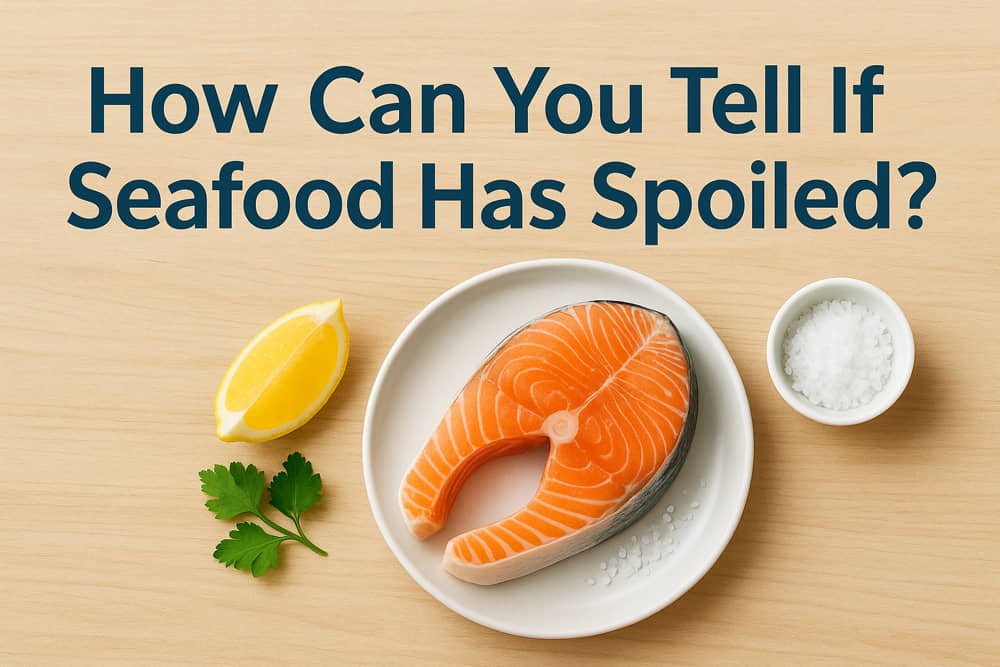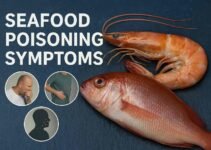Seafood is one of the most beloved delicacies across cultures, but it’s also among the most perishable foods. Consuming spoiled seafood isn’t just a matter of unpleasant taste—it can lead to severe health risks, including foodborne illnesses caused by bacteria such as Vibrio, Salmonella, and Listeria. Whether you’re buying fresh fish from the market or storing shrimp at home, understanding how to assess seafood freshness is essential for both your health and your wallet. This guide will help you confidently recognize spoilage signs based on smell, texture, color, and storage timelines, ensuring that every seafood meal you prepare is both safe and enjoyable.
Contents
- 1 What Are the Most Common Signs That Seafood Has Spoiled?
- 2 How Can You Identify Spoiled Seafood Based on Its Type?
- 3 What Are the Risks of Eating Spoiled Seafood?
- 4 How Long Does Seafood Stay Fresh Under Proper Storage Conditions?
- 5 What Storage Practices Help Prevent Seafood from Spoiling Quickly?
- 6 When Should You Immediately Discard Seafood to Avoid Health Risks?
- 7 Is It Safe to Rely on Visual Inspection Alone to Detect Seafood Spoilage?
What Are the Most Common Signs That Seafood Has Spoiled?
Fresh seafood should always pass three critical sensory tests: smell, texture, and color. These factors provide clear, immediate clues about the product’s freshness and safety.
How does spoiled seafood smell differ from fresh seafood?
Fresh seafood has a light oceanic aroma, often described as clean and salty. Spoiled seafood, however, produces a strong sour, ammonia-like, or rotten smell caused by the breakdown of proteins and bacterial growth. For example, trimethylamine is a compound released during spoilage that creates the unmistakable “fishy” odor. If the scent is overpowering or unpleasant, the seafood should be discarded immediately.
What changes in texture indicate seafood is no longer safe?
High-quality seafood has a firm, elastic texture that returns to its original shape when pressed. If seafood feels slimy, sticky, or mushy, it is a clear sign of bacterial activity and decomposition. This sliminess is a biofilm formed by bacteria on the surface. Fish fillets, shrimp, and shellfish that feel slippery or soft under light pressure should be considered unsafe for consumption.
Does the color of seafood reveal signs of spoilage?
Yes, color is a visual warning sign of spoilage. Fresh fish should have vibrant, natural colors, clear eyes, and bright red gills. Shellfish should have tightly closed shells and appear moist. Seafood that looks dull, has milky liquids, brownish discoloration, or grayish flesh is already in the spoilage stage. Darkened edges on shrimp or black spots on crab meat are also clear indicators that the product is no longer safe to eat.
How Can You Identify Spoiled Seafood Based on Its Type?
Different types of seafood exhibit distinct spoilage characteristics. Understanding these differences helps ensure you never mistake a spoiled product for a fresh one.
What are the signs of spoiled fish (both raw and cooked)?
Raw fish should have bright, translucent flesh and a clean ocean scent. Spoiled raw fish often appears dull, with faded color and dry or sticky surfaces. Cooked fish, when spoiled, develops an off smell and a mushy or overly dry texture. If the flesh easily falls apart or emits a sour odor after cooking, it is no longer safe to eat.
How do you know if shellfish like clams, oysters, and mussels are unsafe to eat?
Shellfish should have tightly closed shells before cooking. If shells remain open when tapped or show cracks, the shellfish are likely dead and unsafe to eat. After cooking, any shellfish that remain closed should be discarded immediately. Additionally, spoiled shellfish often emit a strong, unpleasant odor and appear dry or discolored.
How can you tell if crustaceans like shrimp, lobster, and crab have gone bad?
Fresh crustaceans have firm, moist flesh and a natural sea scent. Spoiled crustaceans may smell sour or ammonia-like and show black spots on their shells or flesh. Shrimp with limp bodies, a slimy coating, or blackened edges should not be consumed. Lobsters and crabs that emit an unusual odor or have discolored meat are also unsafe to eat.
What Are the Risks of Eating Spoiled Seafood?
Consuming spoiled seafood exposes the body to harmful bacteria and toxins, which can lead to severe foodborne illnesses. In some cases, these conditions require immediate medical intervention, particularly for vulnerable groups such as children, the elderly, and individuals with weakened immune systems.
Which bacterial infections are commonly caused by consuming spoiled seafood?
Spoiled seafood is a breeding ground for dangerous bacteria, including Vibrio parahaemolyticus, Salmonella, Listeria monocytogenes, and Clostridium botulinum. These pathogens can cause a range of gastrointestinal issues, from mild food poisoning to life-threatening infections like listeriosis or botulism. For example, Vibrio species are frequently associated with undercooked shellfish and can cause severe diarrhea, vomiting, and fever within 24 hours of consumption.
What are the symptoms of seafood poisoning to watch out for?
The symptoms of seafood poisoning vary depending on the type of bacteria or toxin involved but often include nausea, vomiting, diarrhea, abdominal cramps, fever, and muscle weakness. In severe cases, individuals may experience neurological symptoms such as tingling sensations, difficulty breathing, or even paralysis. Anyone experiencing these signs after eating seafood should seek medical attention immediately.
How Long Does Seafood Stay Fresh Under Proper Storage Conditions?
The shelf life of seafood greatly depends on how it’s stored. Understanding proper storage times helps prevent spoilage and reduces the risk of foodborne illnesses.
How long can you store fresh fish in the refrigerator before it spoils?
Fresh fish should be stored at a temperature close to 0°C (32°F) and consumed within 1 to 2 days. Even under ideal refrigeration, fish can quickly deteriorate due to its high moisture content and delicate protein structure. If you’re unable to consume it within this timeframe, freezing is recommended to maintain quality and safety.
How many days is it safe to keep shellfish and crustaceans refrigerated?
Live shellfish like clams, mussels, and oysters can be stored in the refrigerator for up to 2 days, provided they are kept in a breathable container, such as a mesh bag or a bowl covered with a damp cloth. Cooked shellfish and crustaceans, including shrimp and crab, should be eaten within 2 to 3 days when refrigerated at temperatures below 4°C (39°F).
Does freezing seafood prevent spoilage completely?
Freezing significantly slows down bacterial growth but does not eliminate spoilage risks entirely. While frozen seafood can remain safe for several months, its quality gradually declines. Fatty fish like salmon and mackerel should ideally be consumed within 2 to 3 months, while lean fish such as cod can last up to 6 months. Proper vacuum sealing before freezing helps preserve flavor and texture, minimizing freezer burn.
What Storage Practices Help Prevent Seafood from Spoiling Quickly?
Following proper storage techniques not only extends the shelf life of seafood but also preserves its flavor and nutritional value.
How should you package seafood to extend its shelf life?
Seafood should be stored in airtight containers or vacuum-sealed bags to minimize exposure to air and moisture. If refrigeration is used, place seafood on a bed of ice to maintain a consistently low temperature. For longer storage, vacuum sealing before freezing is highly effective in reducing oxidation and freezer burn.
What is the ideal temperature for storing different types of seafood?
Fresh seafood should always be stored at temperatures close to 0°C (32°F). For frozen storage, keep seafood at -18°C (0°F) or lower. These temperatures inhibit bacterial growth and help preserve the seafood’s texture and flavor. Regularly monitor your refrigerator and freezer to ensure they maintain the correct temperatures.
Can vacuum sealing seafood effectively prevent spoilage?
Yes, vacuum sealing is one of the most effective methods to prevent spoilage. By removing air, it reduces oxidation and bacterial growth, significantly extending the shelf life of both fresh and frozen seafood. Vacuum-sealed fish can last up to twice as long in the freezer compared to non-sealed alternatives. This method also helps preserve the natural flavor and prevents dehydration.
When Should You Immediately Discard Seafood to Avoid Health Risks?
Knowing when to discard seafood is critical to preventing foodborne illnesses. Even if the seafood appears safe at first glance, certain warning signs indicate that it should not be consumed under any circumstances.
What are the irreversible signs that seafood is unsafe to consume?
Seafood should be immediately discarded if it exhibits any of the following signs:
- A strong sour, ammonia-like, or rotten smell.
- Slimy, sticky, or mushy texture that doesn’t bounce back under pressure.
- Dull, faded colors, with grayish or brownish discoloration.
- Cloudy eyes and pale gills in fish.
- Open shells in live shellfish that do not close when tapped.
- Blackened edges or dark spots on shrimp and crab.
If any of these conditions are present, the seafood has likely begun decomposition and poses serious health risks.
Should you trust ‘Use By’ and ‘Sell By’ dates on seafood packaging?
While these dates provide a helpful guideline, they should not be the only factor in determining seafood safety. Sensory checks—evaluating smell, texture, and color—are more reliable indicators of spoilage. Even if seafood is within the labeled date, improper storage conditions can cause it to spoil earlier. Always prioritize physical inspection over packaging dates.
Is It Safe to Rely on Visual Inspection Alone to Detect Seafood Spoilage?
While visual inspection is an important first step, it should never be the sole method for determining seafood safety. Many harmful bacteria and toxins cannot be detected by sight alone.
Why is smell and texture analysis equally important?
Spoilage bacteria produce metabolic byproducts that are often detected through smell and texture before any visual changes appear. For example, Clostridium botulinum can produce deadly toxins without affecting the appearance of seafood. Smelling for sour or ammonia-like odors and checking for sliminess or mushiness ensures a more comprehensive evaluation. If you rely only on visual cues, you risk missing hidden spoilage that could lead to serious health consequences.
Are there any professional tools to test seafood freshness?
Yes, commercial kitchens and seafood suppliers often use specialized tools such as electronic noses (e-noses) to detect spoilage gases or chemical test kits to measure histamine levels, particularly in fish species like tuna and mackerel. While these tools are not commonly used in home kitchens, they are critical for large-scale seafood quality control. For home consumers, relying on a combination of sensory evaluation and proper storage practices remains the most practical and effective approach.
To further reduce the risk of spoilage, ensure that you’re applying proper storage methods at home, especially for delicate seafood items that require strict temperature control and appropriate packaging. You can learn more about these best practices in our detailed guide on how to store fresh seafood for maximum freshness.



